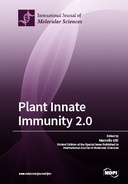Explore

Plants possess a rather complex and efficient immune system. During their evolutionary history, plants have developed various defense strategies in order to recognize and distinguishing between self and non-self, and face pathogens and animal pests. Accordingly, to study the plant innate immunity represents a new frontier in the plant pathology and crop protection fields. This book is structured in 6 sections. The first part introduces some basic and general aspects of the plant innate immunity and crop protection. Sections 2–5 focus on fungal and oomycete diseases (section 2), bacterial and phytoplasma diseases (section 3), virus diseases (section 4), and insect pests (section 5), with a number of case studies and plant–pathogen/pest interactions. The last section deals with plant disease detection and control. The book aims to highlight new trends in these relevant areas of plant sciences, providing a global perspective that is useful for future and innovative ideas.
This book is included in DOAB.
Why read this book? Have your say.
You must be logged in to comment.
Rights Information
Are you the author or publisher of this work? If so, you can claim it as yours by registering as an Unglue.it rights holder.Downloads
This work has been downloaded 334 times via unglue.it ebook links.
- 205 - pdf (CC BY-NC-ND) at Unglue.it.
Keywords
- ?-3 fatty acid desaturase
- Agrobacterium
- agrochemicals
- aphid resistance
- Arabidopsis
- Arabidopsis thaliana
- azelaic acid
- Bacillus subtilis
- Bakraee
- basal defense
- Biological control
- biotic stress responses
- bismerthiazol
- Bromoviridae
- Calcium
- calcium signature
- calmodulin
- Camellia sinensis
- candidate disease resistance gene
- Capsicum annuum
- CaWRKY22
- CaWRKY40b
- CDPKs
- Cell Wall
- cellulose synthase
- chemical elicitors
- Chilo suppressalis
- citrus decline disease
- Citrus sinensis
- CMLs
- defense-related signaling pathways
- dieback
- Disease Management
- Disease Resistance
- downy mildew
- Ectropis obliqua
- ethylene
- ETI
- Food security
- garden impatiens
- gibberellin
- glycerol-3-phosphate
- grapevine
- herbivore-induced defense response
- herbivore-induced plant defenses
- hydroperoxide lyase
- hypersensitive response
- Immunity
- induced defense responses
- innate immunity
- ISR
- iTRAQ
- jasmonic acid
- Lasiodiplodia theobromae
- leaf transcriptome
- light dependent signalling
- Macrosiphum euphorbiae
- Magnaporthe oryzae
- mango
- metabolomics
- methyl salicylate
- microbiota
- mitogen-activated protein kinase 4
- MTI
- Myzus persicae
- N-hydroxypipecolic acid
- negative regulator
- New Guinea impatiens
- Nilaparvata lugens
- OsGID1
- pathogenesis related-protein 2
- pathogenicity
- pipecolic acid
- plant defence
- plant defense response
- Plant Immunity
- plant proteases
- plant protection products
- plant-virus interaction
- plant–microbe interactions
- plant–virus interactions
- polyphenol oxidase
- Potato virus Y
- pre-conditioning
- priming
- Proteomics
- PRRs
- Prune dwarf virus
- PTI
- Ralstonia solanacearum
- regurgitant
- replication process
- Rice
- rice blast
- RNA silencing
- RNA-Seq
- RTNLB
- salicylic acid
- SAR
- SAR signalling
- Sogatella furcifera
- Solanum lycopersicum
- spectral distribution of light
- sustainable crop protection
- Symbiosis
- systemic and local movement
- Tobacco
- tomato gray mold
- tomato leaf mold
- transcriptional modulation
- ultrastructure
- VaHAESA
- wounding
- WRKY networks
- “Candidatus Liberibacter”
- “Candidatus Phytoplasma”
Links
DOI: 10.3390/books978-3-03897-581-6Editions

